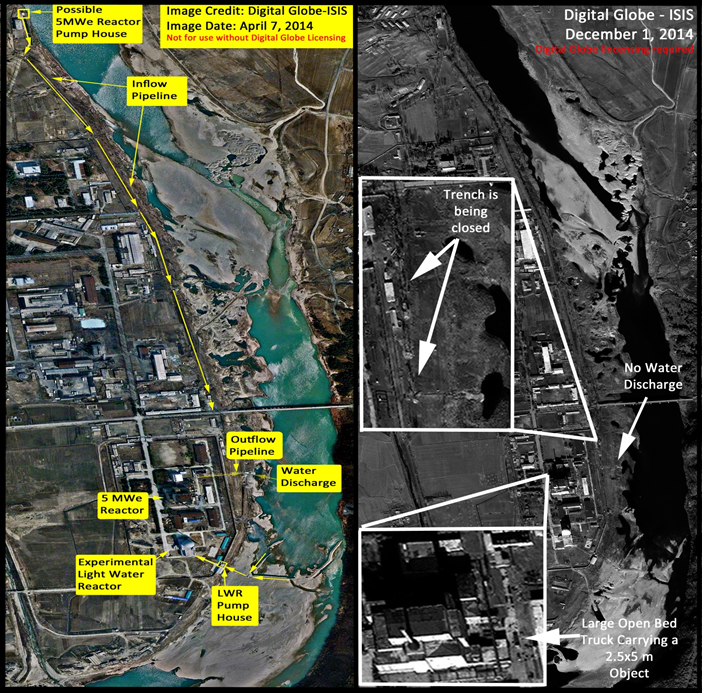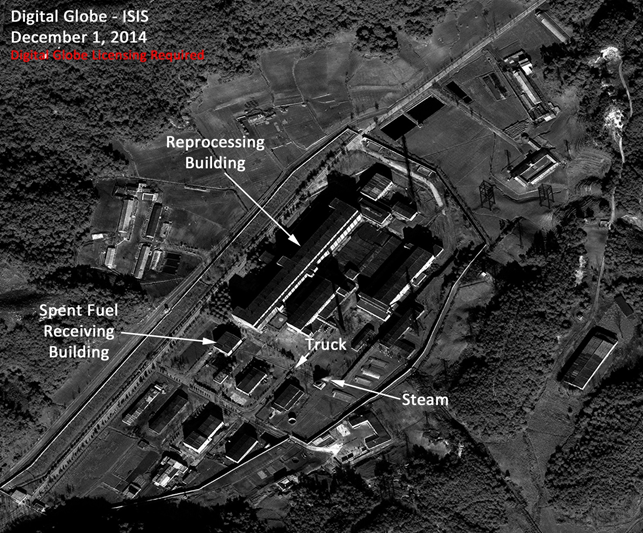Reports
Yongbyon: Monitoring Activities during Shutdown of 5 MW Reactor
by David Albright and Serena Kelleher-Vergantini
December 5, 2014
Digital Globe commercial satellite imagery dated December 1, 2014 continues to show signatures consistent with the shutdown of North Korea’s Yongbyon 5 megawatt-electric (MWe) reactor for maintenance or renovations and possibly some level of fuel replacements. However, caution is warranted: North Korea may also be desperate for plutonium for nuclear weapons and willing to unload the reactor earlier than expected, while also conducting maintenance work on the reactor.
Some signatures are visible at the reprocessing plant located southeast of the Yongbyon reactors, suggesting some level of operation. However, North Korea may also be trying to signal plutonium separation activities without actually conducting any. At the enrichment site, located in the southern part of the Yongbyon nuclear site, roof renovations on a building adjacent to the uranium centrifuge building have halted.
Analysis of imagery dated June 30, August 27, and September 29, 2014, combined with procurement data obtained by ISIS, suggests that North Korea has emphasized the production of weapon-grade plutonium in the 5 MWe reactor as well as enriched uranium for its nuclear weapons program. Analysis of more recent imagery dated December 1, 2014 suggests that North Korea continues to work on maintaining the aged 5 MWe reactor and intends to restart it. The start-up date of the experimental light water reactor (LWR) continues to remain uncertain.
5 MWe Reactor
Analysis of new imagery dated December 1, 2014 appears to support the assessment that the reactor is still not operating at a significant level but instead undergoing some type of maintenance or renovation that started in about August 2014. The December 1, 2014 image shows a very long open bed truck in front of the 5MWe reactor. This truck appears to be carrying a 5 meter by 2.5 meter rectangular or cylindrical tank. One technical expert consulted by ISIS who has often visited the Yongbyon reactor site observed that the truck looks like one carrying CO2 gas used in the reactor’s primary cooling system. This truck has been spotted several times in this location while the reactor was operational. It is unlikely this truck is used to the remove spent fuel from the reactor.
Between September 2013 and June 2014, ISIS assessed that North Korea’s 5 MWe reactor at the Yongbyon nuclear site was operational (see ISIS Imagery Briefs with imagery dated September and December 2013, as well as April and June 2014). This assessment was based on the presence of two important signatures indicating operation: steam venting from the reactor’s turbine building and water being discharged into the river through a pipeline buried east of the reactor (see imagery here). These signatures are related to the reactor’s cooling systems. The 5 MWe reactor has both a primary and secondary cooling system. The primary cooling system involves carbon dioxide for cooling the fissioning, heat producing fuel, while the secondary system uses water to cool the carbon dioxide gas heated by the reactor’s operation. ISIS assesses that the secondary cooling system intakes water via a long pipeline buried north of the reactor and discharges hot water into the river via a shorter pipeline buried east of the reactor (see figure 1).
However, since August 2014, these signatures of steam and water discharges have been absent in the imagery. In the December 1, 2014 image, there is no steam venting from the turbine building and no water is being discharged from the secondary cooling system’s discharge pipeline. The precise reason for the shutdown has not been announced by North Korea. Nonetheless, ISIS assesses that it could be due to maintenance or renovation activities relating to the reactor’s cooling system. For this reason, ISIS assesses that the reactor is likely partially or completely shut down for maintenance and will likely be restarted.
Multiple indicators support that maintenance work is being done. Imagery dated October 28 and November 4, 2014, analyzed and published by 38 North showed that North Korea was digging a trench east of the 5MWe reactor, where ISIS had previously identified the intake piping for the reactor’s secondary cooling system. The recent Digital Globe imagery dated December 1, 2014 purchased and analyzed by ISIS shows that North Korea seems to be covering this trench, indicating the termination of any maintenance or renovation activities.
Although it appears too early for a total core refueling, it is possible that North Korea is carrying out a partial refueling. Some of the fuel rods may be defective and could be being replaced with fresh fuel. Fuel rods could also be shuffled within the core with some being removed and new fuel rods inserted. It is less likely, although not impossible, that the entire core has been removed, since the reactor restarted only about a year ago, according to earlier analyses of satellite images. One would expect the core to remain inside the reactor for at least a few years, based on the reactor’s operational history. The reactor is small and tends to produce plutonium relatively slowly, requiring a few to several years of operation to build up enough plutonium to warrant economically replacing the fuel. For example, after a year’s operation, the current core of fuel could contain up to 3-5 kilograms of weapon-grade plutonium. If the core were not replaced until after two to three years of operation, the fuel in the core would be expected to contain up to double to triple these amounts of plutonium; the exact amount of course would depend on the actual operation of the reactor. Discharging a core containing this amount of plutonium, namely 9-15 kilograms, would be more consistent with past practices. Of course, the question of refueling requires closer scrutiny, because the plutonium would be expected, after separation in the Radiochemical Plant, to be assigned to nuclear weapons. North Korea may be desperate for plutonium for nuclear weapons and be willing to use more fuel than expected to gain access to some of the newly produced plutonium.
Light Water Reactor, Enrichment Plant, and Reprocessing Plant
No new activities have been detected at the enrichment site located across the river in the southern part of the Yongbyon nuclear site.
In addition, the start-up date of the LWR continues to remain unclear. A senior North Korean nuclear official stated in late 2011 that the reactor was expected to be finished by late 2012 or early 2013, although he acknowledged that finishing the reactor would be difficult. In fact, the reactor is still not operational. ISIS has no updated information about this reactor and satellite imagery continues to show no signs of activity or even movement of objects at the site. However, activity may be occurring inside the building; and some foreign procurements continue for this reactor. It is unclear whether North Korea has experienced difficulties finishing the plant or is less committed to its completion.
Some activities have been detected at the reprocessing plant, which is located across the river southeast of the reactor sites. Imagery from November 4th analyzed by 38 North showed that light steam was exiting from what appears to be a small cooling tower or venting system at the site and several vehicles as well as a larger truck (possibly a spent fuel truck) were located close to the spent fuel receiving building at the reprocessing site. More recent imagery dated December 1st also shows light steam exiting from the same cooling tower or venting system. It also shows that a truck (possibly a same spent fuel truck) and a vehicle are present.

Figure 1. Digital Globe imagery showing North Korea’s Yongbyon 5 megawatt-electric (MWe) and experimental light water reactors, and the respective water inflow and outflow systems of the 5MWe reactor on April 7 and December 1, 2014.

Figure 2. Digital Globe imagery showing the Yongbyon Reprocessing Facility on December 1, 2014.

 twitter
twitter